
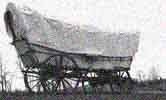
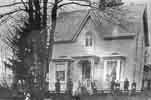
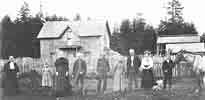
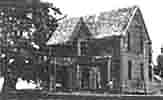
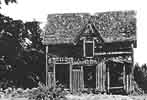
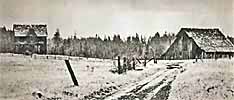
| Home |
| Early Life |
| Maps |
| Oregon Laws |
| The Trail |
| Bush Biography |
| Tumwater Born |
| Thurston County |
| State History |
| Bush
Farm Today |
| FAQs |
| Timeline |
The following data is extracted from John Minto - Man of Courage 1822-1915
by Beverly Elizabeth Lowe, 1980
John Minto was one of the best chroniclers of the General Cornelius Gilliam wagon train of 1844. This train voted to call itself the "Independent Oregon Colony". Minto arrived at Weston, Missouri, near St. Joseph, just in time to join the wagon train which was just starting its trek westward on May 15, 1844. On the first day Minto met Michael T. Simmons who was elected second in command as colonel of the 84 wagons. There were four captains - Wilson Morrison, William Shaw, Allen Saunders and Richard Woodcock. Woodcock's command separated immediately after the formation of a military organization in the first week.
Minto became a valued part of the Morrison party where he worked for board. This party included a coterie of friends from Missouri who became the first American settlers north of the Columbia River. They were G. W. Bush, M.T. Simmons, David Kindred and Gabriel Jones. Mr. Bush was known to be supporting the Kindred and Jones families with wagons and provisions
In sixty-one days the train had progressed only about 200 miles owing to record breaking rain and bad leadership.
Colonel Simmons resigned on July 10 after over a dozen buffalos were slaughtered and abandoned on the plains due to Gilliam’s fondness for hunting game and not leading the wagon train. George Wanch, who boarded with Simmons, was among those who killed game that day. Note. Jacob Hoover was elected to replace Michael Simmons as colonel. Minto considered Hoover a better leader than either Gilliam or Simmons.
General Gilliam resigned command on July 15 after only two months of leadership, leaving the three companies acting independently yet traveling together.
On September 5 Minto recounts, There was…G.W. Bush at whose camp table Rees [also a drover for Morrison] and I had received the hospitalities of the Missouri rendezvous. Joining him as we went on to Soda Springs [in Idaho]. Bush was a mulatto, but had means, and also a white woman for a wife, and a family of five children. Not many men of color left a slave state so well to do, and so generally respected; but it was not in the nature of things that he should be permitted to forget his color. As we went along together, he riding a mule and I on foot, he led the conversation to this subject. He told me he should watch, when we got to Oregon, what usage was awarded to people of color, and if he could not have a free man's rights he would seek the protection of the Mexican Government in California or New Mexico. He said there were few in that train he would say as much to as he had just said to me. I told him I understood. This conversation enabled me afterwards to understand the chief reason for Col. M.T. Simmons and his kindred, and Bush and Jones determining to settle north of the Columbia. It was understood that Bush was assisting at least two of these to get to Oregon, and while they were all Americans, they would take no part in ill treating G.W. Bush on account of his color. No act of Colonel Simmons as a legislator in 1846 was more creditable to him than getting Mr. Bush exempt from Oregon's law, Intended to deter mulattoes or Negroes from settling in Oregon - a law, however, happily never enforced.
On September 16 John Minto, Daniel Clark, and another young man named Samuel B. Crockett struck out for The Willamette from Fort Hall, Idaho, to get help from Oregon. Mr. G.W. Bush, always watchful, followed us out from the wagon and said, ‘Boys, you are going through a hard country. You have guns and ammunition. Take my advice: anything you see as big as a blackbird, kill it and eat it.’ Three young men (Huston Ramsey, Selden Murry, and William Clark) from Colonel Nathaniel Ford's train that were just ahead on the trail soon joined Minto, Crockett and Clark all riding horses..
On October 10 Minto was 22 years old. He was near Pendleton, Oregon, on the west slope of Blue Mountains.
On October 11 the young men met General M. M. McCarver, Speaker of the American Provisional Government of Oregon, and began riding with him to Western Oregon. Minto learned about the details of the new American government in Oregon Country. They met where the Umatilla River joins the Columbia River.
On October 15 John Minto, Daniel Clark, Samuel Ferguson, and Samuel Crockett arrived at The Dalles after a month of severe hunger. Minto, Ferguson and Crockett continued by trail on the south side of the Columbia to The Willamette Valley. The others separated from the group going by the river via canoe. They were General McCarver and Daniel Holman of the emigrants of 1843 and Ramsey, Murry and Clark of 1844. Daniel Clark shot the rapids known as the "Cascades" with the Chinook canoe alone. McCarver asked Dr. McLoughlin for a bateau (flat boat) for travel to The Dalles when passing by Fort Vancouver.
On October 20 Minto and others found work in the Willamette Valley.
On December 3 Minto and others collected a bateau at Linnton furnished by Dr. McLoughlin and paddled east up the Columbia to rescue the remnants of the Gilliam train.
On December 7 they met Mrs. Morrison above the Cascades on the Columbia. She was out of food and in bad condition as were others with her. Captain Morrison was not to be found because he was collecting his cattle that were scattered by a snowstorm between Hood River and The Dalles.
On December 9 Minto arrived at The Dalles for the second time and communicated the Oregon Lash Law to George Bush. A few of Gilliam's train remained for a time at The Dalles. Captain William Shaw stayed at The Dalles on account of the sickness of his son, T.C. Shaw. George W. Bush, one of the most efficient men on the road, stayed all winter taking care of the livestock.
Minto left The Dalles December 26 with the running gear of three wagons and seventeen persons, young and old. The bateau was heavily loaded. Daniel Clark was the steersman. The only delay was the portage of the Cascades. The party landed first near Washougal after a storm on the Lower Columbia.
On December 30 the last immigrants were
unloaded at Linnton and the same day the bateau was
returned undamaged to Dr. McLoughlin at Fort
Vancouver.
Captain Morrison settled on the Clatsop Plains and
Minto returned to Hunt's mill [in Clatsop County,
Oregon] as an assistant in cutting logs.
Then on
about March 1, 1845, Morrison sent Minto a rifle and a
five dollar gold piece to move the livestock from The
Dalles to Washougal. The animals were to be left
at Washougal in the care of George Bush. He
soon caught a ride with two Indian canoes from Fort
Vancouver to The Dalles traveling with the big chief
of the Walla Walla tribe, Peo
Peo Mox Mox. The Big Chief was just returning
from California where he had inquired about the fate
of his son's murderer.
After five days Minto landed near The Dalles for the third
time and met George Bush and his sons who had been
caring for the livestock.
I found Mr. Bush and
others collecting the cattle we had to drive,
and the second morning thereafter we started
out with the herds. There were some
eighty head of cattle, and about twenty head
of horses in a separate drove,
following. The Reverend Waller sent with
us one of his converts of his mission [at The
Dalles], He was a tall, sedate man, by whose
assistance we got our stock safely across to
the north side of the Columbia, making them
swim from a large rock [Ruthton Point]
projecting from the south shore about two and
a half miles west of Hood River. The
cattle had had training in swimming the
streams the previous year, and crossed without
a loss. We hired a large canoe of the
local Indians, and with it took a few of the
most valuable horses alongside the canoe,
urging the others to follow free. This was
successfully done, except that a fine
high-bred mare of H.A.G. Lee died of fright
midstream. I held her by the head all
the way across, and I know that her nostrils
were never in the water - but she was dead
[when] we got to shore. The Indians said it
was fright caused the death, and this was not
unusual. Horses were not so brave in
water as cattle. They had the carcass
out of the sand, skinned, and divided in a
very short time.
We had no trouble in our drive, making the
distance from The Dalles to Washougal in four
days of travel, including crossing the
Columbia.
Leaving the cattle in Mr. Bush's charge, as
ordered, I found my way to Clatsop Plains [near
Astoria] and reported what I had done to Captain
Morrison; and [informed him] I had fulfilled my
verbal agreement made just about one year before…